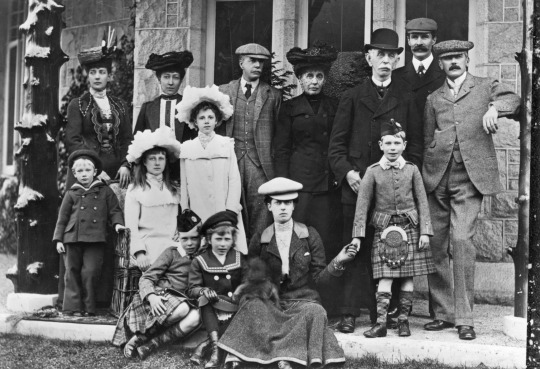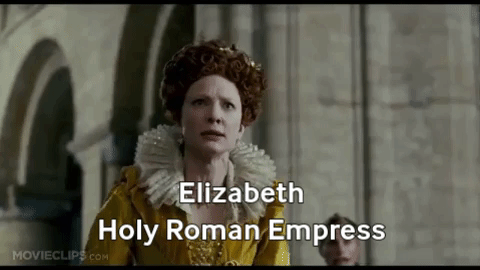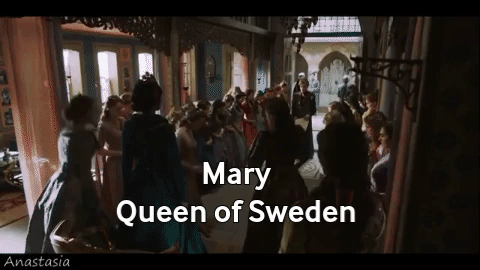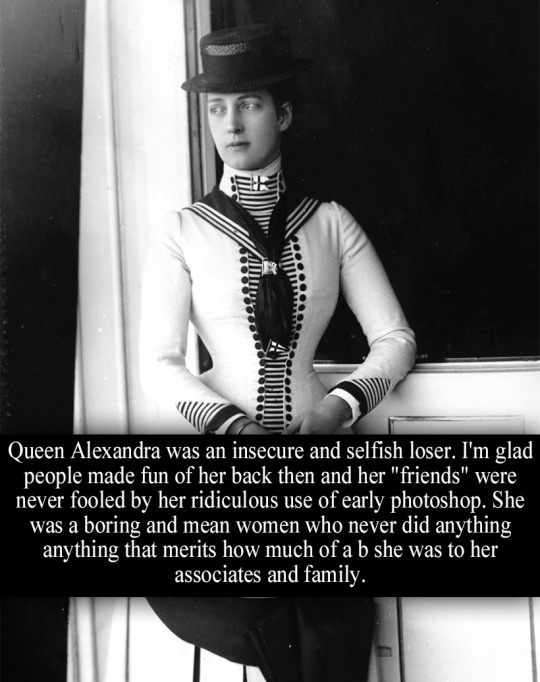#charlotte knollys
Explore tagged Tumblr posts
Text
My favourite scene ever from Edward the Seventh, when King Edward VII is playing golf with his friends then Queen Alexandra and Charlotte Knollys crash the fun. 😂
#istg this scene gets me everytime😭#alix and charlotte are so adorable together<3#king edward vii#queen alexandra#alexandra of denmark#charlotte knollys#edward the seventh#funny
7 notes
·
View notes
Text

1904: A royal family gathering at Mar Lodge in Scotland Back row, from left, Queen Alexandra, Louise, Duchess of Fife, Duke of Fife, The Hon. Charlotte Knollys, Cunningham Graham, King Haakon Children in the middle row, from left, Prince Olaf, Lady Alexandra Duff, Lady Maud Duff Front row, from left, Edward VIII, Princess Mary, and Princess Victoria, holding Prince Albert's hand. (Photo by Hulton Archive/Getty Images)
22 notes
·
View notes
Photo

Ascot Party, 1895.
Left to right; George, Duke of York (1865-1936); Princess Maud of Wales (1869-1938); the Honourable Winifred Sturt (1868-1914) (with violin); unidentified man; Alexandra, Princess of Wales (1844-1925); Honourable Charlotte Knollys (1835-1930); Crown Prince Frederick of Denmark (1843-1912); Princess Victoria of Wales (1868-1935); Crown Prince Constantine of Greece (1868-1923); (in front) Mary, Duchess of York (1867-1953) with her baby son Prince Edward (1894-1972). There is a dog lying on the ground next to Princess Mary.
Source: The Royal Collection
22 notes
·
View notes
Photo






RHistory AU: Anne Boleyn’s sons and daughters
Born on September 7, 1533. Elizabeth was the first born of Anne Boleyn. Her birth was a disappointment to her father, who was hoping for a son. Growing up she was doted on by her mother. At the age of ten she was to France to continue her education. As a young lady she became very adapt at politics. She was spoke five languages and was proficient musician At the age of 16 she married Maximilian II and became the Holy Roman Empress. Though the two had a happy marriage, Elizabeth suffered many miscarriages. Only three children came from their union: Anne, Catherine, and Charlotte. When her husband died in 1576, she acted as regent for her daughter Anne. After Anne took the throne, Elizabeth continued to guide her daughter until her death in 1603.
Born on December 16 1534. Prince Henry was the long awaited son that Henry longed for. Henry was the favorite of his father and this drove a wedge between him and Elizabeth. Anne often had to smooth things out between the two. When Henry died in 1547, Prince Henry became king at thirteen years old. His mother acted as regent until he banished her from court when he was 16. The same year he married Archduchess Anna of Austria. Acting much like his father, he soon banished Anna when she did not give birth to a soon. After divorcing Anna he married Margaret of France. They had four sons; Charles, Henry, Francis, and Edward. During his reign Henry brought England to the fore front of European power. He died in 1580, leaving young Charles to rule.
Born on August 7, 1536. Prince George was the second and last son of Anne Boleyn. Growing up George never shied away from the affection that he got from his father, but he tried to have a relationship with his sister, Elizabeth, she resented him until the last years of his life. As a young man he was an avid hunter and sportsman he spent many years outdoors, and serving as an officer in the English army. In 1570 he met Lettice Knollys, and fell in love. Together they had ten children; Henry, Mary, Anne, Agnes, Elizabeth, George, William, John, Robert, and Margret. The two had a happy marriage until his death in 1625.
Born on October 31, 1537. The triplets, Margret, Mary, and Cecily were born on all Hallows Eve. Were the last children of Anne Boleyn and Henry VIII. All three girls were educated by their mother and then sent to France in the footstep of their elder sister. All three girls held a tight bond throughout their lives. Margret at the age of 15 she married Philip II of Spain. The two had a turbulent marriage, the two often argued and Philip was rumored to be violent with Margret. Their marriage resulted in only two children, Philip, who died in infancy. Only little Charles lived to adulthood, but died at the age of twenty. Margret died in 1567. Mary married Eric XIV of Sweden in 1550. Their marriage too, was a turbulent one. When he started showing signs of mental instability she overthrew her husband and became queen of Sweden. Mary then invited her lover and friend Robert Dudley to Sweden. The two had three children together; Robert, Mary, and Elizabeth. Mary died in 1615. The most ill fated of the children of Anne Boleyn was Cecily. Cecily was rumored to be a witch and had a known love of the occult. At the age of seventeen she married the infamous Ivan the Terrible has his first wife. Their marriage was short lived. The marriage only lasted two years, it was then Ivan discovered the rumors of his wife’s love of the occult. In 1556, he charged her with witchcraft and had her executed in 1557.
#anne boleyn#history au#myedit#english history#queens#queen consort#english queens#henry the viii#henry tudor#elizabeth i#elizabeth tudor#weloveperioddrama#alternate history
87 notes
·
View notes
Photo
Not sure if anyone is even interested in this, and the anon who sent that confession most likely won't see any of it, but I gathered some quotes from various books, shedding light on Alexandra being “selfish and a b to her associates and family.” :)
“Despite these family rifts, Alix always remained kind-hearted. 'Queen Alexandra could never say a hurtful word. Warm, gay, sympathetic, she delighted in always showing kindness... and in sending presents.'” - Alix & Minnie: A Royal Trilogy - Book Three: Widowhood, War, Revolution and Exile by James-Charles Noonan
“Even after all these years I remember her as I saw her then, the grace of her movement, the sweetness of her smile. No woman ever possessed to greater degree that indefinable quality known as charm. That, combined with beauty, will turn anyone's head, unless they be made of stone. Everyone who knew her came under her its spell, grown-ups as well as children, for she could talk to either with equal fascination. She was very witty, brilliant in repartee and a wonderful mimic, yet her wit was never cruel.” - Memoirs of HRH Prince Christopher of Greece
“[…] She asked for the difficult cases and visited them, wandering through the wards with no train of dignitaries in her wake to intimidate patients. She approached beds here and there and sat talking with the inmates. If a patient seemed lonely and unvisited she sent flowers and other gifts. She never forgot a face on a second visit, and even remembered names. She knew all the young probationer nurses and heard about their troubles. Everybody loved her.” - Alexandra, Edward VII's Unpredictable Queen by E.E.P Tisdall
“That autumn at Abergeldie, her woman of the bedchamber Charlotte Knollys fell ill, apparently another victim of typhoid. The 'inevitable' Charlotte was unpopular with the household, but devoted to her mistress, and Alix dropped everything to nurse her, refusing to leave her while she remained ill.” - Bertie: A life of Edward VII by Jane Ridley
“At a Sunday dinner at Marlborough House she [Lillie Langrty, Edward's mistress] became suddenly ill with stomach pains, and Alix implored her to leave early. […] Next day, to Lillie's everlasting delight, Alix called at Norfolk Street, accompanied by Charlotte Knollys, and made tea for her. […] ‘The Princess and Miss Knollys came to see me before they left town and had tea and stayed for an hour. I was so puffed up about it... more especially as she kissed me when she left.'”- Bertie: A life of Edward VII by Jane Ridley
Her friendship with John Merrick, the Elephant Man ???
“Several times the Queen, when Princess of Wales, visited her former teacher and would sit and chat with her in the kindliest manner; and each time that Miss Knudsen [Alexandra's English teacher] has been in England she has been invited by the Princess to tea or luncheon at Marlborough House, and once to dinner tête-à-tête. She was at the garden party the day before the wedding of the then Duke of York, and the Princess, catching sight of her standing apart from the gay throng, hastened to her side and accosted her in Danish, much to the astonishment of some of the great ladies present, who could not imagine who the plainly dressed old woman thus favoured could be. The Princess further arranged for her old teacher to have a good place in the stand of the courtyard of Marlborough House to see the wedding procession next day.”- The life of Queen Alexandra by Sarah A. Tooley
About her appearance:
“But contemporaries always returned to her looks, even the steely-eyed, contentious, Margot Asquith: 'My heart beat when I looked at her [she wrote in her autobiography]. She had more real beauty, both of line and expression, and more dignity than anyone I had ever seen... Queen Alexandra had a more perfect face than any of those [other contemporary beauties] I have mentioned. It is visible now, because the oval is still there, the frownless brows, the carriage and, above all, the grace both of her movement and of gesture which made her the idol of the people.'”- Edward and Alexandra by Richard Alexander Hough
“Even when she had been Queen for more than five years, Daisy, Princess of Pless, another woman of her time who was not easily pleased, exclaimed: 'It really seems quite impossible! She does not look a day older than fifty, and has a lovely figure and a straight back, and fresh red lips that are not painted, as one sees that they are always moist. And I have seen her at Cowes in the pouring rain, and she is certainly not enamelled - and all that nonsense as the people say.'”- Edward and Alexandra by Richard A. Hough
More to be added...

“Queen Alexandra was an insecure and selfish loser. I’m glad people made fun of her back then and her “friends” were never fooled by her ridiculous use of early photoshop. She was a boring and mean women who never did anything anything that merits how much of a b she was to her associates and family.” - Submitted by Anonymous
44 notes
·
View notes
Photo


So I learned something new today, and that is that Elizabeth II is a direct descendant of Mary Boleyn! To be specific, she is her great X12 granddaughter!
Mary Boleyn -> Catherine Carey -> Lettice Knollys -> Robert Devereux -> Frances Deverux -> Jane Seymour -> Charles Boyle -> Richard Boyle -> Charlotte Boyle -> Dorothy Cavendish -> Charles Bentinck -> Charles Cavendish-Bentinck -> Cecilia Cavendish-Bentinck -> Elizabeth Bowes-Lyon -> Elizabeth II
Source
59 notes
·
View notes
Note
Did AAlexandra have friends?
Yes she did! 😊
She made great friends with her ladies-in-waiting, and probably other other workers. And one of her favourite friends, Charlotte Knollys, was one of the main courtiers of King Edward VII and Queen Alexandra! Charlotte worked as a Lady of the Bedchamber, and as the first woman private secretary of Queen Alexandra!


6 notes
·
View notes
Text
Queen Alexandra as Mother-in-Law
...about two years before King Edward [VII]’s death there had been an urgent conclave between the King, Miss Charlotte Knollys--Queen Alexandra’s lady in waiting--and Lord Ormathwaite. They were in a dilemma because the Queen had a bad cold and the doctors insisted on her staying in bed. There was to be a Court the next day and Her Majesty said that as she could not hold it, it must be put off. The King protested that this would be impossible at such short notice, and Lord Ormathwaite, who was H.M. Master of Ceremonies, and responsible for the Courts, agreed with him. Finally the king said that the Princess of Wales was to hold the Court with him. Lord Ormathwaite, who waited while the decision was conveyed to Queen Alexandra, said that her anger rang through the corridors, but the King was firm and she had to give in.
As Lord Ormathwaite was leaving he heard Charlotte Knollys stumping behind him. She had a message from the Queen.
“Her Majesty says that none of her ladies are to attend the Princess tomorrow, and that the Duchess of Buccleuch [Mistress of the Robes to Queen Alexandra] is not to go to the Court. The Princess can take her own ladies.”
“How am I to tell the King this?” Lord Ormathwaite said helplessly.
Charlotte Knollys turned on her heel. “Perhaps I had better tell him.” And stumped away.
The Princess of Wales held the Court the next day with her own ladies and with no Mistress of the Robes.
-- Mabell, Countess of Airlie, Thatched with Gold, pp. 107-8
31 notes
·
View notes